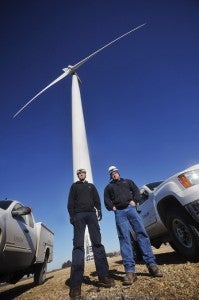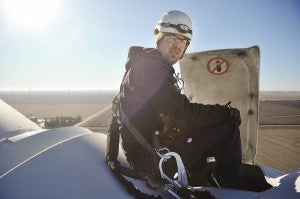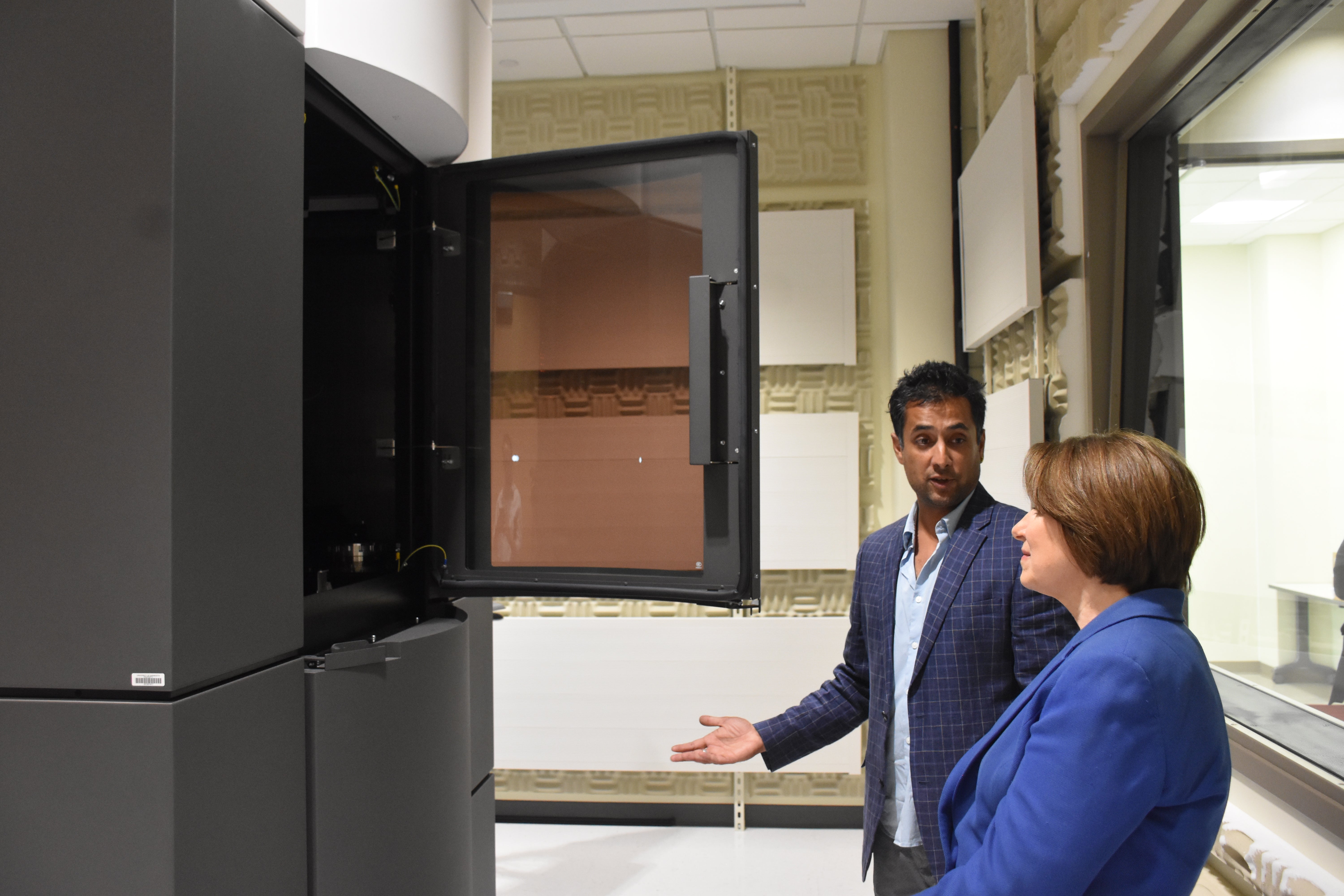Tall tasks
Published 12:10 am Thursday, April 5, 2012
[imagebrowser id=2572]
Wind farms producing jobs, energy in region
This story originally appeared in Progress 2012. Get a copy at the Austin Daily Herald.
Craig Wiste wanted to try something new.
After working as an auto mechanic, one could say he literally took his skills to the next level when he harnessed in and started climbing hundreds of feet to service wind towers.

Craig Wiste and Eric Anderson are lead technicians for Vestas out the LeRoy Office, helping keep the windtowers under their watch up and working.
“It’s pretty untested waters for the most part for everybody in this area,” said Wiste, now a lead technician with Vestas Americas in LeRoy.
Since 2002, companies have erected 253 wind turbines in Mower County, plus hundreds more across Minnesota and Iowa. The job of keeping those turbines producing falls on the shoulders of wind technicians, a job in which most take great pride.
“There’s something really satisfying about getting a multi-million dollar piece of machinery running again,” Wiste said.
Minnesota has quickly become a leader in wind power, and ranked third in 2010 with 9.7 percent of the state’s energy derived from wind, according to an American Wind Energy Association report. Some statistics say that number is now higher than 15 percent, and AWEA reports show the renewable source could provide about 25 times the state’s electricity needs.
The state has more than 2,500 megawatts on line, producing enough energy to power 700,000 homes.
“The winds here and the conditions are just really good for wind energy,” said Michelle Berdusis, site manager of the LeRoy Vestas office, which employs more than 30 technicians. “That’s why we’re in business: We have to keep them producing.”
The job
Though wind towers have become a prominent part of the local skyline, most people don’t realize the effort it takes to maintain them.
Wiste compared the job to routine maintenance performed by an auto mechanic, but on a larger scale.

Craig Wiste, a lead technician for Vestas out of LeRoy, walks across from the nacelle to the hub of a wind turbine south of Grand Meadow.
“Everything’s so big. Everything’s higher voltages,” he said. “You’re not running around with a little torque wrench like you are on a car. … You’re using big tools and heavy tools. Guys really have to take care of themselves up there when they’re working.”
Each turbine requires a once- or twice-annual maintenance that includes checking oil filters, greasing gears, cleaning and torquing bolts, and checking for leaks.
A lot of times, issues will show up during a scheduled maintenance. The goal is to save themselves from extra work later and keep the turbines producing for their customers: the energy company.
“Our guys take a lot of pride in their work,” said lead technician Eric Andersen. “They make sure that they catch everything they can during routine service, and that really minimizes the chance of a turbine faulting.”
The 30 Vestas employees in LeRoy maintain 243 turbines — 182 in Iowa and 61 in Minnesota.
“You can about imagine that we never get a break,” Wiste said. “By the time you finish the last one, you start the new one.”
While the job requires skills in mechanics, electricity and hydraulics, no other job can fully prepare a technician for work on a turbine.
“It’s a job like no other,” Wiste said.

ead Vestas technician out of LeRoy, Craig Wiste sits on the hub of a wind turbine south of Grand Meadow before sliding inside.
While many people spend workdays at paper-littered desks, the bulk of a wind farm technician’s day is spent in a turbine’s nacelle, the top base of the turbine that houses the bulk of the machinery.
“You get so used to it. It doesn’t feel unsafe at all,” Wiste said. In fact, the company prides itself on safety and holds safety meetings every morning.
Though some towers have climb assists or lifts, many workers reach the nacelle by harnessing into a guide wire and scaling the ladder — located inside the turbine — so a climber’s back is near the turbine wall.
Still, the climb isn’t always easy.
“If you’re going to go out to do a routine maintenance, and you haven’t done it in two weeks, you’d be amazed how difficult it is for your muscles to collect that,” Wiste said.
As lead technicians, Wiste and Andersen spend more time on the ground, managing others and helping general technicians.
Along with routine maintenance, technicians also take turns being on call. During their week, they’ll focus on alarm turbines, which makes for about 10-hour days, plus some weekend and night work.
“Everyday’s the same, yet everyday’s a little different,” Andersen said.
Most of the alarm work consists of electrical problems like loose wires or a hydraulic issue. Wiste said they rarely see the same issue break down a turbine twice, and a variety of different things cause a breakdown.
“It’s definitely a unique job,” Andersen said.
Security — literally and figuratively
While wind farm technicians pride themselves on job safety, many are just as comfortable with job security.
“Nobody here has had to worry about if they’re going to have a job tomorrow,” Wiste said.
The 253 turbines in Mower County have brought many jobs to the region.
Along with a good wind resource and willing land owners, Riverland Community College wind technician instructor Steve Vietor said Minnesota has a strong electrical grid to support wind development. Plus, the state has another key ingredient: young people.
“We’ve got a resource in this area of youth who want to go to work in this industry,” he said.
Along with Vestas, there are at least two other turbine maintenance shops based in Mower County.
The Riverland wind technician program currently has about 20 students in their first year and 15 students in their second year, and they don’t seem to have any trouble finding jobs, according to Vietor.
Many of the students find work within a 50-mile radius of the Austin/Albert Lea area, according to Vietor, but students who are willing to travel can reel in bigger paychecks.
The typical starting salary for a wind technician is comparable to starting pay in the electrical and mechanical industries: anywhere from $15 to $24 per hour.
At Vestas, the typical wage for an entry-level service technician is between $18 and $20 an hour, plus employees receive strong benefits; fully paid healthcare, a 401(k) retirement program and generous vacation and sick leave, according to Andrew Longeteig, a communications specialist with Vestas.
The company aims to promote people from within and keep them in the company, too.
Traveling technicians who work at multiple sites can make $20,000 to $30,000 or more, and some even make $80,000 annually, according to Vietor.
Vietor said there’s a lot of room for advancement.
“It’s a pretty interesting field for somebody who wants to attend a two-year program,” he said.
Along with LeRoy, Vestas has offices and turbines near Dodge Center and Albert Lea.
Berdusis said most of the employees at the LeRoy office have been there through the entire project — more than four years.
“We try to keep them in the industry and in Vestas,” Berdusis said.
Furthermore, the need for workers doesn’t seem to be diminishing.
“These things are standing here,” Wiste said. “It’s kind of like a car. Cars are always going to break down. You have to have your car fixed. These turbines are here. It’s pretty good job security.


